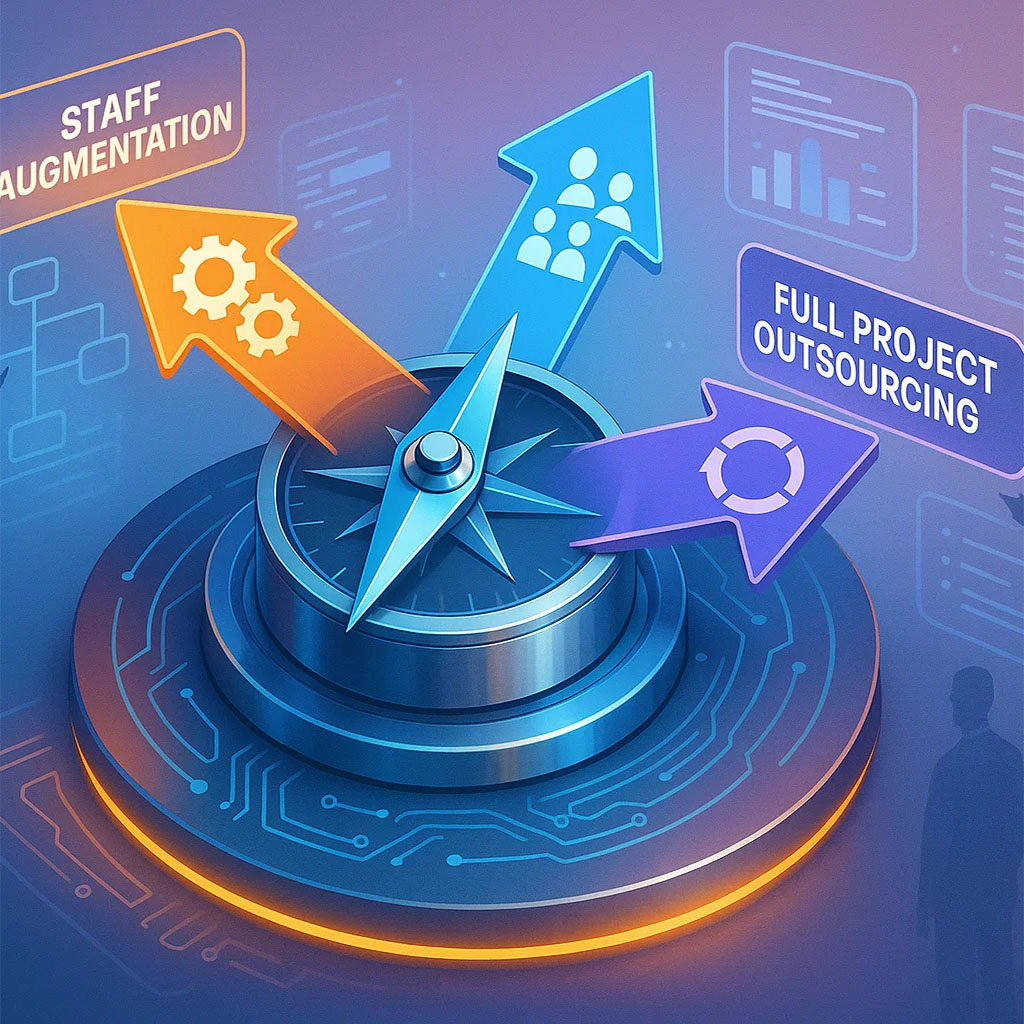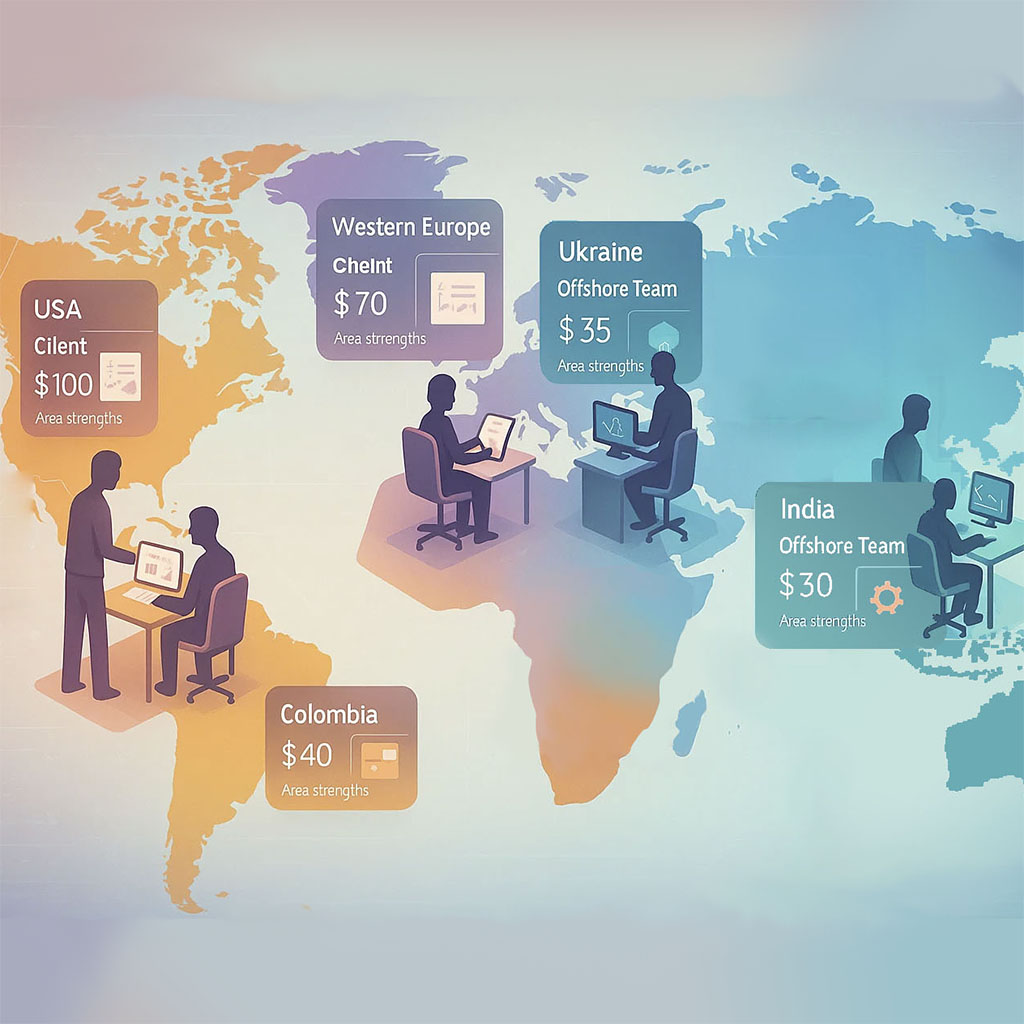Introduction
Short answer
Outsourcing app development in 2025 can cut costs by 50% or more, speed up delivery by up to 50%, and provide access to global talent. But it’s not a cure-all. Success depends on choosing the right outsourcing model, budgeting carefully, and managing risks proactively.
According to IT outsourcing market data & analysis by Statista, the outsourcing app development market in 2025 is projected to hit $591.24 billion — a number that tells one clear story: companies are betting big on external development teams to stay competitive. But here’s the part they don’t advertise: outsourcing isn’t a magic bullet. Done wrong, it leads to project delays, hidden costs, and apps that don’t scale.
So, how do you do it right?
This guide breaks down everything: costs, best practices, risk management, legal considerations, and the latest trends shaping outsourcing in 2025. Whether you’re a startup founder, a CTO, or a product manager weighing your options, this is the no-fluff, real-world roadmap to making outsourcing work for you.
Let’s get into it.
The business case for outsourcing app development

Companies outsource to save money, speed up delivery, access specialized talent, and focus on core business. 1. To cut costs
In-house: $100K–$500K/year or $40–$80/hour.
Outsourced: 50–70% cheaper depending on region.
Popular regions: India, Eastern Europe, Latin America.
2. To launch faster
24/7 progress across time zones. Parallel development (frontend/backend/testing).
Agile delivery = faster MVPs. 3. To access global talent
Hard-to-hire skills (AI, blockchain).
Talent hotspots: 4. To focus on core business
Skip hiring hassle.
Scale easily.
Focus on branding, marketing, fundraising.Short answer
Country
Strengths
Ukraine
AI, blockchain, enterprise software
Poland
Web/mobile/finance apps
India
Large dev pool, cost-effective
Mexico
Proximity to U.S.
First of all, we should answer the following question:
If it’s clear that companies are increasingly relying on external development teams to stay competitive, why is outsourcing becoming the go-to solution?
Here is the detailed answer.
To cut costs
Building an app yourself can be a real drain on resources. Think about salaries, benefits, equipment, and the time it takes to find the right people. When you look at the numbers, here’s what you see:
| How you develop | Cost (per year/project) |
| Build it in-house | $100,000–$500,000 (or $40–$80/hour) |
| Hire someone else | Could be 50–70% less, depending on the location |
Going with someone else to build your app can save you cash, especially if you look at places overseas. Just remember to factor in stuff like how easy it will be to communicate and how well the new app fits with your old systems.
To get to the market faster
Getting your app out there quickly is super important. Outsourcing can help you with that because:
- You can have people working on it around the clock in different parts of the world.
- Different teams can handle different parts of the app at the same time (the front end, the back end, testing, etc.).
- You can use Agile methods to put out versions bit by bit, which means getting your basic app (MVP) launched sooner.
For instance. One startup in the U.S. worked with a team in Eastern Europe. Since they were on opposite sides of the world, the app was being worked on all the time—when the U.S. team was asleep, the other team was working. They got the app done way faster (30–50% faster!) than if they’d done it themselves. The key is to stay organized so things don’t get mixed up.
To find the right talent
It can be tough to find skilled developers in your area, especially if you’re working with new stuff like AI or blockchain. Outsourcing lets you tap into talent pools all over the world, specifically in places like India, Poland, Ukraine, and Mexico.
Did you know. A Deloitte study says that most companies are rethinking their outsourcing, focusing on places with top-tier skills.
| Country | Strengths |
| Belarus, Ukraine | AI, blockchain, complicated business software |
| Poland | Web and phone apps, finance apps |
| India | Lots of developers, good prices, low quality |
| Mexico | Convenient for U.S. companies (close by!) |
Using global talent is great, but you need to make sure the work is up to par.
To focus on what you’re good at
Instead of trying to manage a tech team, outsourcing lets you pay more attention to your core business, like planning, marketing, and raising money. By letting others handle the app, you can:
- Spend more time on important business decisions.
- Skip the hassle of hiring and managing developers.
- Be flexible and scale your team as needed.
For instance: An online store in the U.S. outsourced its app to a company in Poland that specialized in React Native. They got a working app in just four months, and the company was able to focus on branding, finding products, and getting customers.
Outsourcing takes some of the weight off, but you still need to have a clear plan and make sure the outsourced team is on the same page as you.
Main points
- Money: Outsourcing can cut your app costs in half (or more!).
- Speed: You can get your product out faster with teams all over the world. Just remember to keep track of time zones.
- Skills: You can find experts in things like AI, blockchain, and finance.
- Focus: Outsourcing lets you grow your business while ensuring your app is well-made through careful oversight.
Picking the way to outsource app development that fits your case

Choose based on your needs, skills, and budget. Options include staff augmentation, dedicated teams, and full project outsourcing.Short answer
Model
Best For
Control
Cost
Tech Skill Needed
Timeframe
Staff Augmentation
Quick hires for niche skills
High
High
High
Short
Dedicated Team
Long-term scalable development
Medium
Medium
Medium
Medium-Long
Full Outsourcing
Non-tech founders, end-to-end needs
Low
Low
Low
Long
It’s not a one-size-fits-all deal. A lot of companies struggle because projects, budgets, and skills inside the company are all different. You might just need some help for a bit, a whole team for a while, or someone to take care of the whole thing. Knowing what’s good, bad, and how much it costs for each is super important.
Staff augmentation (good for quick, special jobs)
- Who it’s for: Startups and companies that need a specific skill (like AI, blockchain, or security) but don’t want to hire someone full-time.
- How it works: You bring in outside developers to work with your team, adding their skills to what you already do. The outside team follows how you manage things to make sure everyone’s on the same page. Contracts are easy, with options to pay by the hour or month.
- What’s good: You get access to really good people without a long commitment. Hiring is faster than finding someone yourself. You stay in charge of how the project goes.
- What’s not so good: You need good leaders who know their stuff to get the outside people working well with your team. It can be hard to get everyone on the same page, so you need a plan to get them started.
- How much it costs: Expect to pay $40–$120 an hour, depending on the skills and where they are.
Dedicated development team (good for long projects)
- Who it’s for: Companies that want to grow their tech teams without hiring people themselves. Great for projects that go on for a while, like software platforms or finance apps.
- How it works: You get a whole team (developers, managers, designers, testers) that only works on your project. That way, they really get to know what’s going on. The vendor takes care of HR, payroll, and all that stuff, which saves you money and time. It works well if you need them for six months or more, and you can add or take away people as needed.
- What’s good: Having the same team means they really know your project and get things done faster in the long run. It’s cheaper than building your own team when you count hiring and training. It’s easy to add or remove people as you need them.
- What’s not so good: You need to be ready to spend some money and have a clear plan for the long haul. Planning ahead is key to getting the most out of it.
- How much it costs: Expect to pay $35–$100 an hour, depending on where they are.
Full project outsourcing (good for people who aren’t techy)
- Who it’s for: Startups and companies that don’t have tech skills and want someone to handle everything.
- How it works: You give the whole project to an agency that does it all. They take care of planning, designing, building, testing, and keeping it running. You can pay a set price, pay by the hour, or have a retainer agreement.
- What’s good: You don’t have to do much, so you can focus on your business. Agencies already have processes and know what they’re doing, which saves time. You can get a fixed price for the project, which makes budgeting easier.
- What’s not so good: You don’t have as much control over what’s happening, so you need to trust the agency. You need to plan everything out in detail upfront to avoid surprises.
- How much it costs:
- Fixed price: $30,000–$250,000 per project.
- Hourly rate: $30–$150 an hour, depending on how hard it is and where they are.
Which one should you pick?
| Factor | Staff Augmentation | Dedicated Team | Full Project Outsourcing |
| Best for | Short-term needs, special tasks | Long projects, growing teams | Non-techy founders, full outsourcing |
| Management control | High | Medium | Low |
| Cost | High (pay per hour) | Medium (monthly) | Low (fixed project cost) |
| Time commitment | Short | Medium-long | Long |
| Tech skills needed | High | Medium | Low |
Summing up
Picking the right outsourcing way depends on what you need, what tech skills you have, and how much you can spend. If you have skills in-house but need extra help, staff augmentation is easy. For a continuous need for a team, a dedicated development service is consistent. If you don’t have tech leadership and need someone to handle it all, project outsourcing is best.
Next up, we’ll look at how much outsourcing costs in different places and how to budget it all.
The costs of outsourcing app development

Costs vary by region, complexity, and tech stack. Budgeting well is key to avoiding financial pitfalls.
Rates by region
Complexity vs. CostShort answer
Region
Hourly Rate (USD)
Best For
North America
$100–$250
AI, advanced security
Western Europe
$75–$200
Enterprise-grade apps
Eastern Europe
$35–$100
Great value and skills
India/SE Asia
$20–$50
Budget-conscious projects
Latin America
$40–$70
Time-zone convenience for the U.S.
Hidden costs
Maintenance: 15–30% annually
Project Type
Cost (USD)
Timeframe
Simple App
$5K–$80K
2–4 months
Medium Complexity
$20K–$300K
4–7 months
Complex/Enterprise
$250K–$500K+
8+ months
Hosting: $500–$10K/month
API/Licensing: $1K–$10K/year
Security/Compliance: GDPR, HIPAA
QA/Testing: $10K–$50K
Outsourcing is a great way to save money, but where you go and how you plan can make a huge difference. Picking the correct outsourcing option is about finding the sweet spot of value and quality. So, let’s break down what you need to know to budget well.
Where to find developers and what it costs
Here’s a fresh look at what you might pay developers in different parts of the world in 2025, based on our analysis of multiple sources (Golden Owl, Wappnet Systems, Cubix, Ptolemay, DistantJob, CodeSuite, etc.), combined with our own findings:
| Place | Rate (USD per hour) | Good for |
| North America | $100–$250 | Apps needing AI or top-notch security |
| Western Europe | $75–$200 | Solid, business-ready apps |
| Eastern Europe | $35–$100 | Good skills at a decent price |
| India/SE Asia | $20–$50 | If you’re on a tight budget |
| Latin America | $40–$70 (estimation) | Handy if you’re in the U.S. (same time zones!) |
How location affects what you pay
Where your team is located really changes the total cost. For a medium-sized app build, you might pay $100,000–$300,000 in North America. However, that same app might only cost $40,000–$120,000 in Eastern Europe or even less, around $30,000–$80,000, in Southeast Asia.
Also, think about using tools like Flutter or React Native for your app. They let you build for multiple platforms at once, and this could bring expenses down by 30–40% versus building separate apps for each platform. Just make sure these savings don’t lead to performance issues that cost you later!
How complex the project is vs the cost
| Complexity level | Cost range (USD) | Typical features | Development timeframe |
| Simple app | $5,000–$80,000 | Basic design, few features, simple database | 2–4 months |
| Medium complexity | $20,000–$300,000 | Custom design, several integrations, some AI | 4–7 months |
| Complex/Enterprise | $250,000–$500,000+ | AI, AR/VR, blockchain, high security | 8+ months |
Don’t forget about these hidden costs
Outsourcing can save you cash upfront, but some sneaky expenses can pop up later.
- App maintenance. Budget 15–30% of what you spend building the app each year for updates, fixing bugs, and making sure it works on new devices.
- Cloud and server hosting. Plan to spend $500–$10,000 each month, depending on how much your app is used and how much it needs to grow.
- Third-party API and licensing fees. Set aside $1,000–$10,000 per year. The amount depends on which services you use.
- Security and compliance costs. Make sure you follow rules like GDPR and HIPAA right from the start. A lack of compliance can lead to big fines.
- Quality assurance and testing. Allocate $10,000–$50,000 for thorough testing on different devices.
- Technical debt. Global losses of $5 trillion over the next decade.
- Software-quality hits. $2.42 trillion in annual U.S. write-offs.
- Knowledge-sharing gaps. $2.1 million average annual hit per company.
- IP theft. $180–$540 billion lost in the U.S. each year.
- Compliance fines. Up to $50 million per incident.
- Vendor lock-in. 40–60 percent of your original budget.
| Hidden Cost | Annual Impact | Budget Buffer |
|---|---|---|
| Technical debt | $5 trillion globally/decade | 15–20 % for refactoring |
| Knowledge transfer losses | $2.1 million/org | 5–10 % escrow fund |
| IP theft risk | $180–$540 billion (U.S.) | 3–5 % security spend |
| Compliance violations | Up to $50 million/incident | 2–8 % compliance fund |
| Vendor lock-in | 40–60 % of original budget | 10–15 % open-standards |
| Geopolitical delays | 20–100 % cost surge | 5–10 % contingency |
2025 geopolitical risks
Recent tensions mean “where” matters as much as “who.” Here’s your response playbook:
| Region | Political Risk | Mitigation |
|---|---|---|
| Eastern Europe | High (Ukraine conflict) | Backup teams in Poland/Romania |
| China/Asia | Medium (trade disputes) | IP compartmentalization |
| India | Low | Primary operations hub |
| Latin America | Low-Medium | Nearshoring alternative |
Smart ways to budget for outsourcing in 2025
Here’s how to get the most from your outsourcing investment:
- Know exactly what you want. Nail down all the requirements before you start so things don’t get out of hand.
- Pick the right payment plan. Go with a fixed price for small projects. If things might change a lot, pay as you go or get a dedicated team for long-term needs. Think about the risks of each choice.
- Remember maintenance costs. Save at least 20% of your budget each year for updates.
- Think about security early. Factor in regulations like GDPR and HIPAA from the get-go.
Summing up
Where you choose to outsource and how well you budget can really affect your success. A poorly planned budget can be a financial pit. North America and Western Europe have top-notch experts, but they come at a premium, while Eastern Europe, Southeast Asia, and Latin America offer budget-friendly options that don’t skimp on quality. If you understand the hidden costs and plan carefully, you can outsource smartly and stay on budget.
Next up, we’ll show you how to pick the best outsourcing partner and dodge common traps.
How to pick the right outsourcing partner
Short answer
Pick partners with relevant experience, strong communication, and secure, scalable tech practices.
Step-by-Step Guide
Define Your Project: Goals, MVP vs full app, budget.
Check Tech Skills: Tech stack, past projects, code quality.
Evaluate Communication: Tools (Slack, Jira), meeting cadence, time zone overlap.
Review Reputation: Clutch, GoodFirms, client testimonials.
Test with a Pilot Task: Build a small feature or prototype.
Get Legal Protection: NDA, MSA, SOW, SLA, GDPR/HIPAA compliance.
So, you’re thinking about outsourcing. Many companies do it to get access to talent or to focus on their core business. How do you make sure you pick the right team and not end up with a headache?
We at Elmosoft are fully committed to your proper partner selection. Here’s how to vet potential outsourcing partners for a good working relationship.
Step 1. Nail down your project
Before you even start looking, get crystal clear on what you need. What are your project aims, scope, and tech requirements? Knowing this upfront helps you find a team with the right skills.
Figure out your app’s type:
- Native app or cross-platform?
- Minimum viable product (MVP) or the whole project?
- Just the basics or something fancy (AI, blockchain, AR/VR)?
Sort out budget and timeline:
- What features must you have, and what can wait?
- Don’t forget about extra costs (keeping it running, cloud stuff, legal compliance).
- Is a fixed price or paying by the hour a better deal for your project?
Step 2. Check their tech skills
Got your requirements down? Now, see what these outsourcing companies can actually do.
Scope out their past work
- Do they have projects like yours in their portfolio?
- How’s the design, speed, and user-friendliness?
- Have they worked in your industry before (finance, healthcare, online stores, etc.)?
Skills and tech stack
- Native dev. Swift (iOS), Kotlin (Android).
- Cross-platform. Flutter, React Native.
- Backend. Node.js, Python, Ruby on Rails.
- Databases. PostgreSQL, MongoDB, Firebase.
Code quality
- Ask to see some code they’ve written (like on GitHub).
- Is it clean, well-explained, and built to grow?
Tip. Teams following practices like Agile, continuous integration, and automated testing are generally better organized, which helps smooth communications.
Step 3. How well do they communicate?
At Elmosoft, we craft backend solutions with Java, Python, and Node.js that are not only secure but also grow with you. We make sure they fit right in with the best cloud platforms out there. When it comes to what users see, we’re all about React, Angular, and Vue.js. This means your web apps will be quick and always changing.
Elmosoft
To keep everything running smoothly, we depend on tools such as Selenium, Appium, TestComplete, JMeter, and Cucumber for rigorous testing and automation, making software dependable and high-performing. With Docker, Selenoid, and Splunk, we make scaling, keeping watch, and getting stuff done across every project easier.
Good talks are a must. Make sure the outsourcing team plays nice and has a solid process.
What tools do they use?
- Slack, Microsoft Teams. For daily updates and quick chats.
- Jira, Asana, Trello. To track tasks and plan sprints.
- Zoom, Google Meet. For regular check-ins and updates.
How do they manage projects?
- Agile (Scrum/Kanban). Works great if you want to be flexible.
- Waterfall. Okay for projects where everything’s planned out.
Set expectations
- Will there be daily stand-ups or weekly meetings?
- Tracking progress by milestones helps dodge delays.
Warning sign. If there are language barriers or slow responses, you’ll probably have issues.
Step 4. What do others say?
See what other clients think. Good reviews are a good sign.
Where to find reviews:
- Clutch.co Claimed as real client reviews. However, it’s not so hard to bypass their anti-fake security measures.
- GoodFirms.co. Checks out IT service companies.
- Upwork. Ratings and work history for freelancers and agencies.
Ask about past projects and clients:
- Get some in-depth examples of their work.
- Talk to their former clients to see how it went.
- Do they have clients that stick around for a long time?
Step 5. Try them out
Before you commit, give them a small task to see what they’re like to work with.
Ideas for a test project:
- A simple prototype or one small feature.
- Fix a bug in an existing app.
- A sample design for the user interface.
Tip. A good partner will tell you how to make things better, not just do what you say.
Step 6. Contracts
To keep your ideas safe and everyone on the same page, get some contracts in order.
2025’s rulebook goes deeper than NDAs:
- Data-privacy laws: Delaware PDPA (Jan 1, 2025), new U.S. state bills, GDPR fines up to £3.95 million.
- Mandatory certifications: ISO-27001 for any partner handling data.
- Outcome-based contracts:
- 99 percent code-quality targets
- Shared-savings risk models
- Measurable technical-debt reduction
- IP protection:
- Blockchain-logged dev records
- “Clean-room” builds with third-party checks
- Knowledge-escrow agreements
Sophisticated vendor evaluation matrix
| Category | Weight | Criteria | Min Score |
|---|---|---|---|
| Technical capability | 25 % | Portfolio depth, AI integration, code | 8/10 |
| Security & compliance | 20 % | ISO, IP controls, GDPR | 9/10 |
| Cultural alignment | 15 % | Comm style, problem-solving match | 7/10 |
| Business continuity | 15 % | Geo-spread, backup systems | 8/10 |
| Innovation capability | 10 % | AI tools, emerging tech | 7/10 |
| Financial stability | 10 % | Credit rating, client retention | 8/10 |
| Geopolitical risk | 5 % | Political/regulatory stability | 7/10 |
| Overall threshold | Composite ≥ 80/100 |
Next up: How to manage an outsourced project well.
Making outsourcing work for you: Tips and tricks
Short answer
Clear planning, weekly check-ins, strict scope control, and secure collaboration help ensure project success. Tips Use milestone payments. Apply MoSCoW for feature prioritization. Run unit, integration, and performance tests. Communicate asynchronously via shared docs. Schedule overlapping work hours (3–5 hrs). Respect cultural differences.Outsourcing can be risky, but smart moves can stop problems before they start. Here’s what Elmosoft advises to handle the main issues:
Deadlines missed or things taking too long
What to do:
- Pay when things are done, not before.
- Plan for delays – add extra time to your schedule.
- Check-in weekly to see how things are going and catch problems early.
The project getting bigger than planned
What to do:
- Make sure everyone knows what’s included from the start.
- Have a process for adding new stuff to the project.
- Decide what’s most important using the MoSCoW method (Must-have, Should-have, Could-have, Won’t-have).
Worries about secrets and security

What to do:
- Sign NDAs before sharing anything private.
- Make sure your contracts say you own everything created.
- Choose teams that are good at security (like using encryption and following GDPR/HIPAA rules).
Look at this. Some companies didn’t protect their ownership, which caused legal fights over who owned the app.
AI-enhanced outsourcing management
Let machines catch slip-ups before they cost you:
- Real-time code analysis. Instant feedback on every commit.
- Automated quality gates. Block low-quality code from merging.
- Predictive bug detection. ML flags hotspots before testing.
- Performance-based payments. Tie fees to AI-measured outcomes—fewer bugs, faster launches.
Making sure things are done right
Test new stuff slowly
- Try out new things with a few users before showing everyone.
- Watch what people say and fix problems fast.
Check things automatically
- Unit testing. Check each part works by itself.
- Integration testing. Check all the parts work together.
- Performance testing. Check how fast and strong the app is.
Have a backup plan
- If something goes wrong, go back to the old version of the app.
Good advice. The CISA and FBI Software Deployment Guide says to test slowly and have a backup plan to avoid big problems.
Time zones and culture: Working with teams far away
Different time zones and cultures can make teamwork hard. Here’s how to make it easier:
Have some hours in common
- Make sure you have at least 3–5 hours where everyone is working at the same time for meetings.
Talk without meetings
- Write down everything in shared spots (Notion, Confluence) to talk without needing to meet all the time.
Be nice and flexible
- Understand that people have different ways of working, different holidays, and ways of talking to build strong relationships.
For instance. Startups in the U.S. working with teams in Eastern Europe often have meetings in the morning to match the afternoon there.
By doing these things, you can avoid problems, keep things good, and have better relationships with your outsourcing partners.
What’s next?
Outsourcing your app development can really change things for the better if you handle it well. It can help companies save money, get the best talent from around the world, and get their product out faster. But to make it work, you need to pick the right outsourcing plan, handle the risks, and keep communication open during the whole process.
Main points
- Save money. Outsourcing could cut your development costs in half or even more compared to keeping everything in-house.
- Stay flexible. Pick from adding staff, using dedicated teams, or outsourcing the whole project, depending on what you need.
- Keep quality up and risks down. Check out partners closely, get agreements signed, and use flexible ways of working to get stuff done quickly.
- Plan for the future. Use things like AI and cloud development to keep costs down and performance up.
What you should do now
- Figure out what you need. Before you outsource, know what your budget is, what the project involves, and what tech you need.
- Pick the right plan. Choose a staffing way that fits what your business wants to achieve.
- Check out possible partners. Look at their past work, what clients say about them, and examples of what they’ve done before you commit.
- Have a plan for the long run. Think about maintenance costs, following the rules, and how you might need to grow later.
Key takeaways
Outsourcing can transform your app idea into reality faster and cheaper—if you plan smart, choose the right model, and partner wisely.
Key Points
Cut costs: Save up to 70%.
Speed up: Global teams mean faster delivery.
Access skills: Hire top-tier experts worldwide.
Stay focused: Let experts build while you grow.
What To Do Now
Define your goals and budget.
Choose the right outsourcing model.
Vet and test potential partners.
Plan for scaling and long-term maintenance.
Start smart. Scale fast. Win with the right outsourcing strategy in 2025.
Ready to get smarter about outsourcing?
If you do it the right way, outsourcing can turn your app idea into a great product that can grow with you – all without costing too much. No matter if you’re starting up, managing products, or a CTO, this advice should help you make smart outsourcing choices that bring success now and later.
Now’s the time to get moving, check out your choices, find the right team, and start building!
By Egor Kaleynik
IT-oriented marketer with B2B Content Marketing superpower. HackerNoon Contributor of the Year 2021 Winner – MARKETING. Generative AI enthusiast.
Featured in: Hackernoon.com, Customerthink.com, DZone.com, Medium.com/swlh
More info: https://muckrack.com/egor-kaleynik
Credibility Hub

